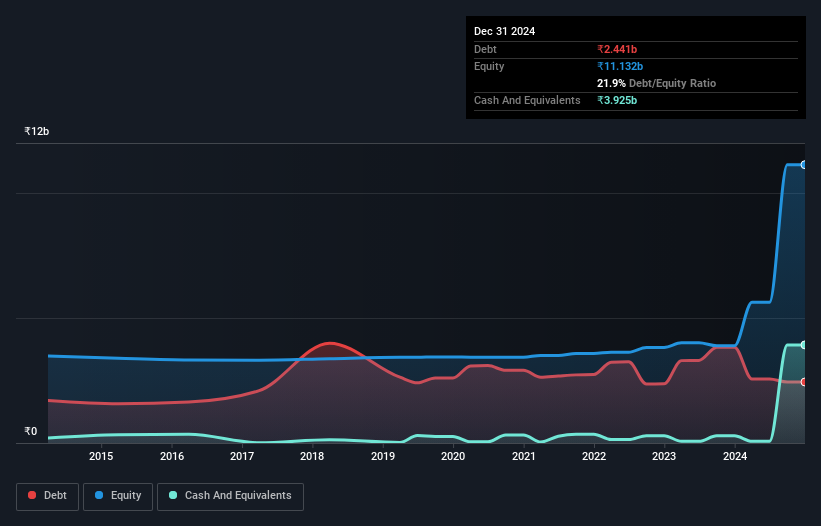- India
- /
- Electrical
- /
- NSEI:TARIL
Here's Why Transformers and Rectifiers (India) (NSE:TARIL) Can Manage Its Debt Responsibly
Some say volatility, rather than debt, is the best way to think about risk as an investor, but Warren Buffett famously said that 'Volatility is far from synonymous with risk.' It's only natural to consider a company's balance sheet when you examine how risky it is, since debt is often involved when a business collapses. As with many other companies Transformers and Rectifiers (India) Limited (NSE:TARIL) makes use of debt. But should shareholders be worried about its use of debt?
When Is Debt Dangerous?
Generally speaking, debt only becomes a real problem when a company can't easily pay it off, either by raising capital or with its own cash flow. If things get really bad, the lenders can take control of the business. However, a more common (but still painful) scenario is that it has to raise new equity capital at a low price, thus permanently diluting shareholders. Of course, debt can be an important tool in businesses, particularly capital heavy businesses. When we examine debt levels, we first consider both cash and debt levels, together.
Check out our latest analysis for Transformers and Rectifiers (India)
How Much Debt Does Transformers and Rectifiers (India) Carry?
You can click the graphic below for the historical numbers, but it shows that Transformers and Rectifiers (India) had ₹2.44b of debt in September 2024, down from ₹3.83b, one year before. However, its balance sheet shows it holds ₹3.92b in cash, so it actually has ₹1.48b net cash.

A Look At Transformers and Rectifiers (India)'s Liabilities
According to the last reported balance sheet, Transformers and Rectifiers (India) had liabilities of ₹6.11b due within 12 months, and liabilities of ₹312.1m due beyond 12 months. On the other hand, it had cash of ₹3.92b and ₹6.59b worth of receivables due within a year. So it can boast ₹4.09b more liquid assets than total liabilities.
This surplus suggests that Transformers and Rectifiers (India) has a conservative balance sheet, and could probably eliminate its debt without much difficulty. Simply put, the fact that Transformers and Rectifiers (India) has more cash than debt is arguably a good indication that it can manage its debt safely.
Better yet, Transformers and Rectifiers (India) grew its EBIT by 246% last year, which is an impressive improvement. That boost will make it even easier to pay down debt going forward. There's no doubt that we learn most about debt from the balance sheet. But it is future earnings, more than anything, that will determine Transformers and Rectifiers (India)'s ability to maintain a healthy balance sheet going forward. So if you want to see what the professionals think, you might find this free report on analyst profit forecasts to be interesting.
But our final consideration is also important, because a company cannot pay debt with paper profits; it needs cold hard cash. While Transformers and Rectifiers (India) has net cash on its balance sheet, it's still worth taking a look at its ability to convert earnings before interest and tax (EBIT) to free cash flow, to help us understand how quickly it is building (or eroding) that cash balance. Over the last three years, Transformers and Rectifiers (India) recorded negative free cash flow, in total. Debt is usually more expensive, and almost always more risky in the hands of a company with negative free cash flow. Shareholders ought to hope for an improvement.
Summing Up
While it is always sensible to investigate a company's debt, in this case Transformers and Rectifiers (India) has ₹1.48b in net cash and a decent-looking balance sheet. And it impressed us with its EBIT growth of 246% over the last year. So we are not troubled with Transformers and Rectifiers (India)'s debt use. Above most other metrics, we think its important to track how fast earnings per share is growing, if at all. If you've also come to that realization, you're in luck, because today you can view this interactive graph of Transformers and Rectifiers (India)'s earnings per share history for free.
At the end of the day, it's often better to focus on companies that are free from net debt. You can access our special list of such companies (all with a track record of profit growth). It's free.
Valuation is complex, but we're here to simplify it.
Discover if Transformers and Rectifiers (India) might be undervalued or overvalued with our detailed analysis, featuring fair value estimates, potential risks, dividends, insider trades, and its financial condition.
Access Free AnalysisHave feedback on this article? Concerned about the content? Get in touch with us directly. Alternatively, email editorial-team (at) simplywallst.com.
This article by Simply Wall St is general in nature. We provide commentary based on historical data and analyst forecasts only using an unbiased methodology and our articles are not intended to be financial advice. It does not constitute a recommendation to buy or sell any stock, and does not take account of your objectives, or your financial situation. We aim to bring you long-term focused analysis driven by fundamental data. Note that our analysis may not factor in the latest price-sensitive company announcements or qualitative material. Simply Wall St has no position in any stocks mentioned.
About NSEI:TARIL
Transformers and Rectifiers (India)
Manufactures and sells transformers in India.
Exceptional growth potential with outstanding track record.
Market Insights
Community Narratives



